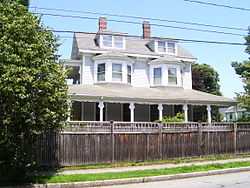Celia Thaxter
| Celia Thaxter | |
|---|---|
 | |
| Born |
June 29, 1835 Portsmouth, New Hampshire, United States |
| Died |
August 25, 1894 (aged 58) Appledore Island, Isles of Shoals, Maine United States |
| Occupation | Poet and writer |

Celia Laighton Thaxter (June 29, 1835 – August 25, 1894) was an American writer of poetry and stories. She was born in Portsmouth, New Hampshire.
Life and work
Thaxter grew up in the Isles of Shoals, first on White Island, where her father, Thomas Laighton, was a lighthouse keeper, and then on Smuttynose and Appledore Islands.
When she was sixteen, she married Levi Thaxter and moved to the mainland, residing first in Watertown, Massachusetts, at a property his father owned. In 1854, they accepted an offer to use a house in Newburyport. The couple then acquired their own home, today called the Celia Thaxter House, built in 1856 near the Charles River at Newtonville. She had two sons, one of whom was Roland, born August 28, 1858, who would later become a prominent mycologist who taught at Harvard where he studied insect-associated fungi and Myxobacteria. Her first published poem was written during this time on the mainland. That poem, "Land-Locked", was first published in the Atlantic Monthly in 1861 and earned her $10.[1]
Her life with Levi was not harmonious and she missed her islands, and so after 10 years away, she moved back to Appledore Island.
Celia became the hostess of her father's hotel, the Appledore House, and welcomed many New England literary and artistic notables to the island and to her parlor, including writers Ralph Waldo Emerson, Nathaniel Hawthorne, Henry Wadsworth Longfellow, John Whittier, Sarah Orne Jewett, and the artists William Morris Hunt and Childe Hassam, who painted several pictures of her. The watercolorist Ellen Robbins also painted the flowers in her garden. Celia was present at the time of the infamous murders on Smuttynose Island, about which she wrote the essay, A Memorable Murder. In 2008, The Library of America selected "A Memorable Murder" for inclusion in its two-century retrospective of American True Crime.[2]
William Morris Hunt, a close family friend, spent the last months of his life on Appledore Island, trying to recover from a crippling depression. He drowned in late summer 1879, three days after finishing his last sketch. Celia Thaxter discovered the painter's body, an apparent suicide. That same year, the Thaxters bought 186 acres (75 hectares) along Seapoint Beach on Cutts Island, Kittery Point, where they built a grand Shingle Style "cottage" called Champernowne Farm. In 1880, they auctioned the Newtonville house, and by 1881, moved to the new home. It stayed in the family until the 1989 death of her granddaughter and biographer, Rosamond Thaxter.
Her poems first appeared in The Atlantic Monthly and she became one of America's favorite authors in the late 19th century. Among her best-known poems are The Burgomaster Gull, Landlocked, Milking, The Great White Owl, The Kingfisher, and especially The Sandpiper.[3]
Celia Thaxter died suddenly while on Appledore Island. She was buried not far from her cottage, which burned in the 1914 fire that destroyed The Appledore House hotel.[4]
Images
| Wikimedia Commons has media related to Celia Thaxter. |
-

Celia Thaxter, 1889
-

Thaxter's home in Watertown
-

The Celia Thaxter House in Newtonville
-

Thaxter's cottage on Appledore Island
-

Celia Thaxter in her Garden, 1892, by Childe Hassam
Notes
- ↑ Walker, Cheryl. American Women Poets of the Nineteenth Century: An Anthology. Rutgers, The State University Press, 1992 (1995 reprint): 293. ISBN 0-8135-1791-5
- ↑ Rosamond Thaxter, Sandpiper—The Life and Letters of Celia Thaxter; Peter E. Randall, publisher, Portsmouth, New Hampshire 1963
- ↑ Vallier, Jane (1994). Poet on Demand: The Life, Letters, and Works of Celia Thaxter. Peter E. Randall. ISBN 978-0-914339-47-2.
- ↑ Mandel, Norma. "Celia Thaxter Timeline".
External links
| Library resources about Celia Thaxter |
| By Celia Thaxter |
|---|
| Wikiquote has quotations related to: Celia Thaxter |
- A Memorable Murder
- Childe Hassam: American Impressionist, a full text exhibition catalog from The Metropolitan Museum of Art, which contains material on Celia Thaxter
|